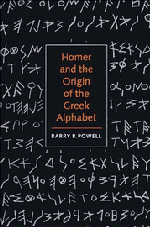Book contents
- Frontmatter
- Contents
- List of figures
- List of tables
- Acknowledgements
- Abbreviations
- A note on terms and phonetic transcriptions
- Chronological charts
- Maps
- Foreword: Why was the Greek alphabet invented?
- 1 Review of criticism: What we know about the origin Greek alphabet
- 2 Argument from the history of writing: How writing worked before the Greek alphabet
- 3 Argument from the material remains: Greek inscriptions from the beginning to c. 650 b.c.
- 4 Argument from coincidence: Dating Greece's earliest poet
- 5 Conclusions from probability: how the Iliad and Odyssey were written down
- APPENDIX I Gelb's theory of the syllabic nature of West Semitic writing
- APPENDIX II Homeric references in poets of the seventh century
- Definitions
- Bibliography
- Index
3 - Argument from the material remains: Greek inscriptions from the beginning to c. 650 b.c.
Published online by Cambridge University Press: 01 June 2011
- Frontmatter
- Contents
- List of figures
- List of tables
- Acknowledgements
- Abbreviations
- A note on terms and phonetic transcriptions
- Chronological charts
- Maps
- Foreword: Why was the Greek alphabet invented?
- 1 Review of criticism: What we know about the origin Greek alphabet
- 2 Argument from the history of writing: How writing worked before the Greek alphabet
- 3 Argument from the material remains: Greek inscriptions from the beginning to c. 650 b.c.
- 4 Argument from coincidence: Dating Greece's earliest poet
- 5 Conclusions from probability: how the Iliad and Odyssey were written down
- APPENDIX I Gelb's theory of the syllabic nature of West Semitic writing
- APPENDIX II Homeric references in poets of the seventh century
- Definitions
- Bibliography
- Index
Summary
The earliest examples of the Greek use of the alphabet appear scratched on vases and painted on a clay plaque…Some of them are in verse, and it may even have been this new alphabet which enabled Homer to compose and set down his great poem(s)…
(J. Boardman)That the alphabet “might have been invented as a notation of Greek verse” is a rather attractive idea, and one wishes it could be proved…
(R. Pfeiffer)THE LACK OF SEMANTIC DEVICES IN EARLY GREEK WRITING
Certain formal features of early Greek alphabetic writing suggest, prima facie, a notational system based directly on the users' immediate perception of speech as a continuous stream of sound, a perception in agreement with Wade-Gery's hypothesis; for this stream of sound may well have been aoidic song. These features are, first, the lack of word, clause, and sentence division in archaic Greek inscriptions (and much later ones too), and, second, the boustrophedon style.
The lack of word, clause, and sentence division
The separation of one word from another was an old achievement of earlier writings. In Egyptian, phonetic and semantic indicators make clear demarcations between words, and sometimes between clauses and between sentences; in Cypriote and Phoenician a dot, some other mark, or a space divides one word from another. But in all Greek inscriptions dated before c. 650 b.c., only the Pithekoussan “Cup of Nestor” (below, inscription no. 59 163ff.) and the early sherds from the Potters' Quarter at Corinth (below, inscription no. 21 133ff.) show any evidence of semantic indicators.
- Type
- Chapter
- Information
- Homer and the Origin of the Greek Alphabet , pp. 119 - 186Publisher: Cambridge University PressPrint publication year: 1991



